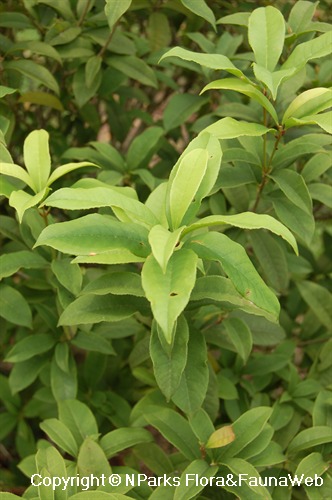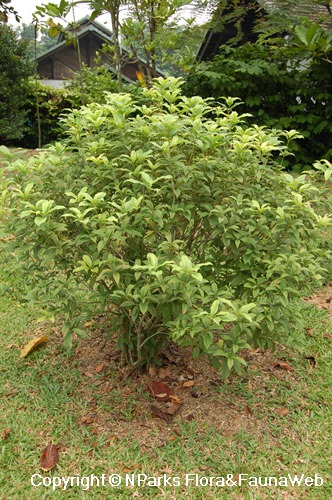
Back
Osmanthus fragrans Lour.
| Family Name: | Oleaceae |
| Synonyms: | Olea frangrans |
| Common Name: | Fragrant Olive, Sweet Tea, Sweet Olive, 桂花 |
Name
Classifications and Characteristics
| Plant Division | Angiosperms (Flowering Seed Plants) |
|---|---|
| Plant Growth Form | Shrub, Tree (Small (6m-15m)) |
| Lifespan (in Singapore) | Perennial |
| Mode of Nutrition | Autotrophic |
| Maximum Height | 6 m |
| Maximum Plant Spread / Crown Width | 2.5 m |
Biogeography
| Native Distribution | East Asia |
|---|---|
| Native Habitat | Terrestrial |
| Local Conservation Status | Non-native (Horticultural / Cultivated Only) |
Description and Ethnobotany
| Growth Form | An evergreen or large woody shrub with an upright growth. |
|---|---|
| Foliage | The simple leaves are glabrous and elliptic to elliptic-lanceolate in shape and are arranged in opposite pairs along the stem. |
| Flowers | The small, white flowers are borne on cymes, clustered in the leaf axils and have a very strong fragrance of ripe apricots. |
| Fruit | The fruit is in the form of a purple-black drupe. |
| Cultivation | It is ideally grown under full sun to partial shade and is best grown in moist, well-drained and acidic soil but tolerates heavy clay soils. It is drought-tolerant once established and may be grown as a small tree or shrub. |
| Etymology | The genus name 'Osmanthus' is derived from the Greek word 'osma' meaning fragrant and 'anthos' which means flower. |
| Ethnobotanical Uses | Edible Plant Parts : Edible Flowers Food (Herb or Spice): The flowers are used in China to infuse with black or green tea to created a scented tea called guì huā chá (桂花茶). Medicinal: It is used by the Chinese as a medicinal plant as protection against coughs and is used to flavour other medicines. |
Landscaping Features
| Desirable Plant Features | Fragrant |
|---|
Plant Care and Propagation
| Light Preference | Full Sun |
|---|---|
| Water Preference | Moderate Water |
| Plant Growth Rate | Slow |
Foliar
| Foliage Retention | Evergreen |
|---|---|
| Foliar Type | Simple / Unifoliate |
| Foliar Arrangement Along Stem | Opposite |
| Foliar Attachment to Stem | Petiolate |
| Foliar Margin | Serrulate |
Fruit, Seed and Spore
| Mature Fruit Colour(s) | Black, Purple |
|---|---|
| Fruit Classification | Simple Fruit |
| Fruit Type | Fleshy Fruit , Non-Accessory Fruit |
Image Repository
Others
| Master ID | 993 |
|---|---|
| Species ID | 5290 |
| Flora Disclaimer | The information in this website has been compiled from reliable sources, such as reference works on medicinal plants. It is not a substitute for medical advice or treatment and NParks does not purport to provide any medical advice. Readers should always consult his/her physician before using or consuming a plant for medicinal purposes. |



